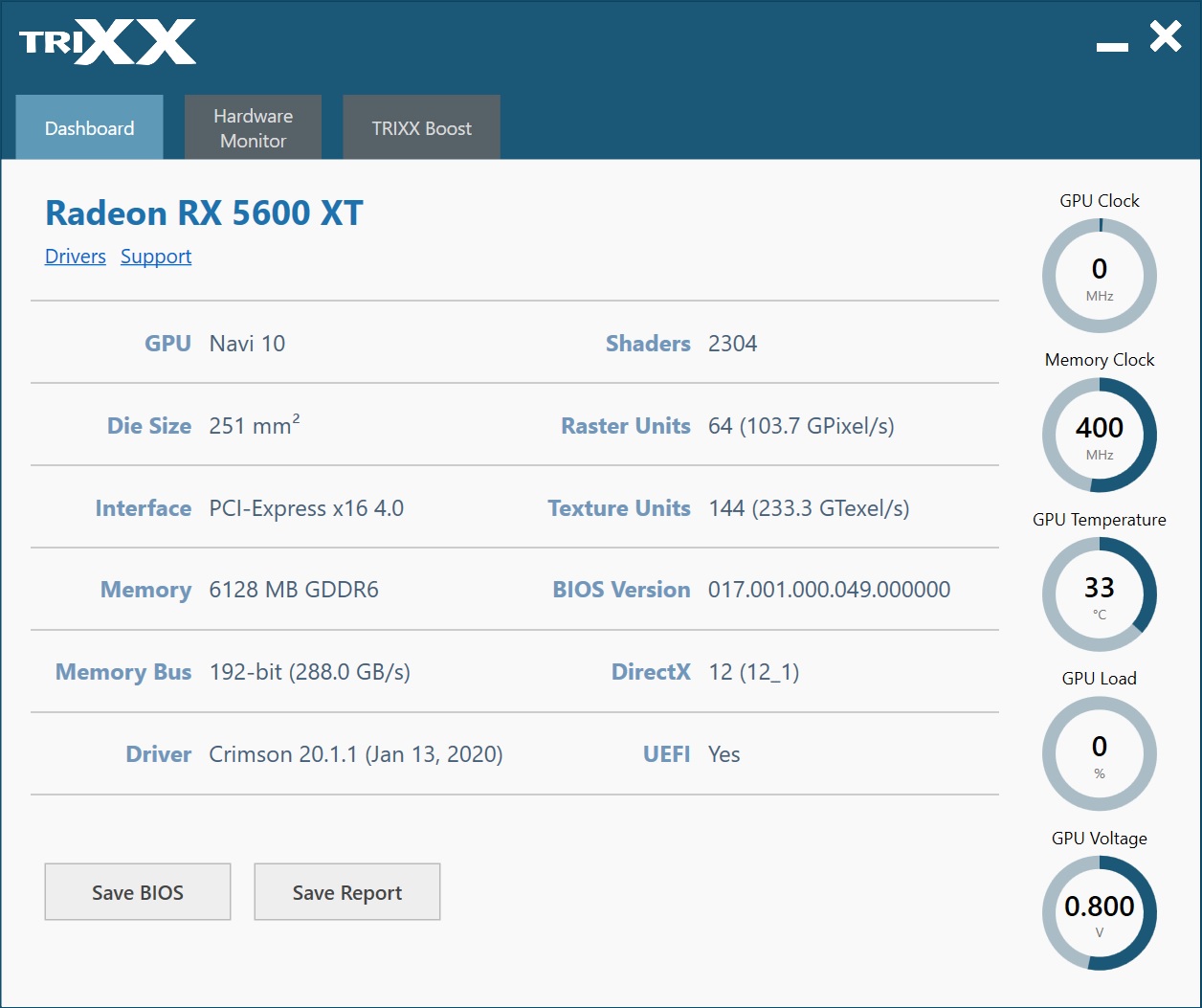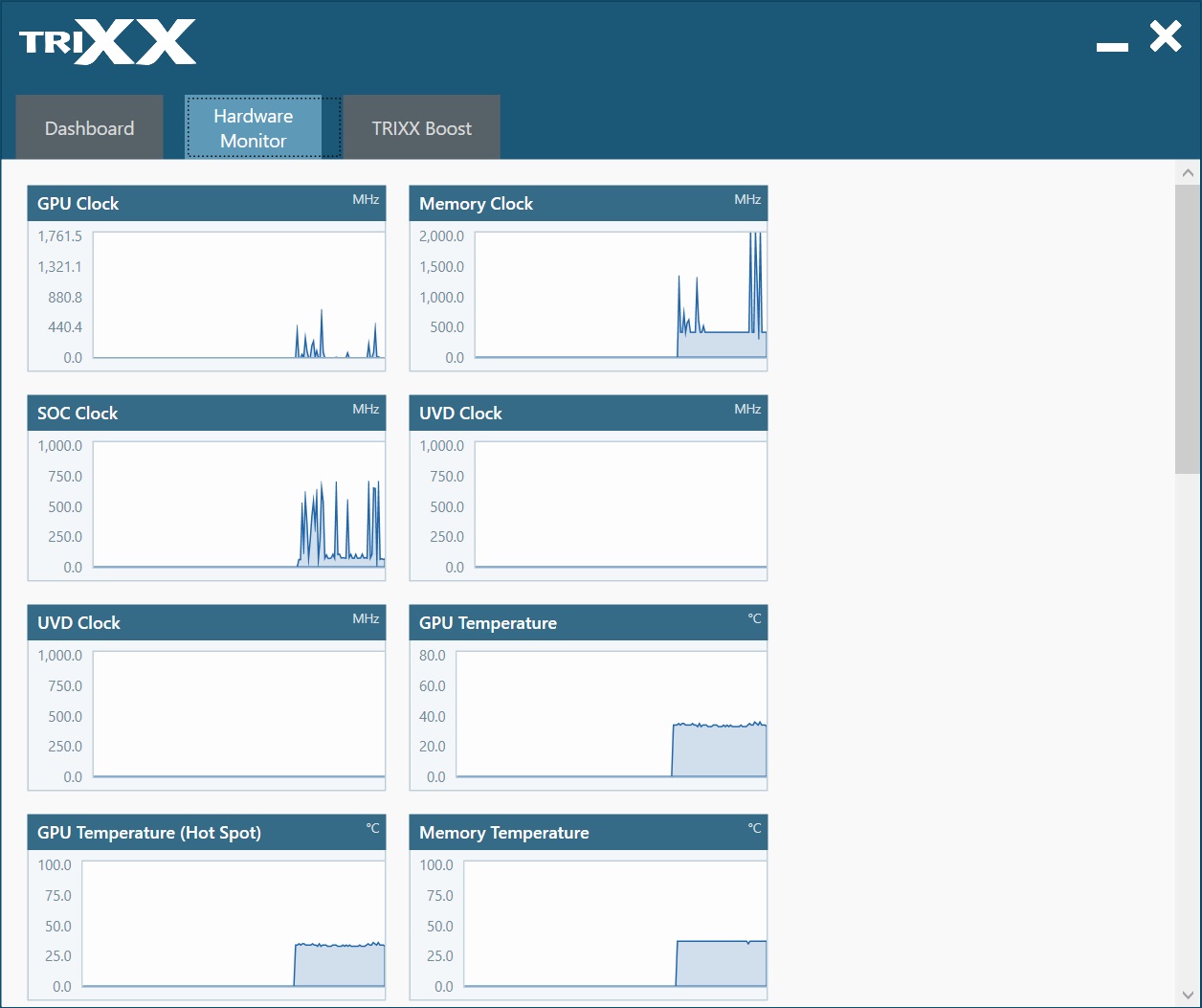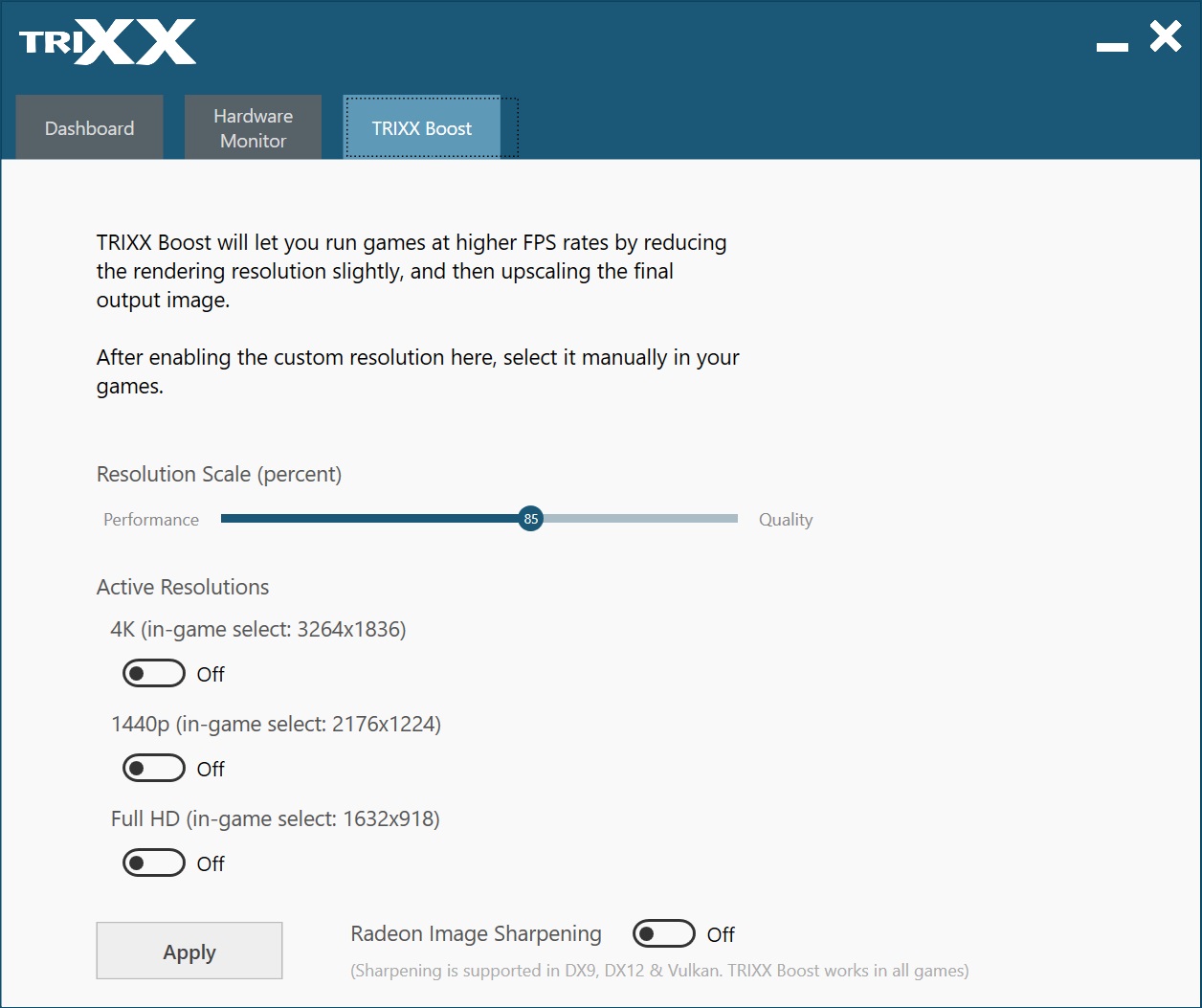Why you can trust Tom's Hardware

Sapphire’s TriXX software supports the new RX 5600 XT Pulse OC, and sports a recently re-designed GUI along with other updates. The software’s main screen, called Dashboard, includes GPU and Memory clock rates along with GPU temperature and GPU load indicators. Current GPU voltage is displayed as well. Other information on the screen includes details about the card, from the GPU specs along with the currently installed driver.

The Hardware Monitor tab displays information in real time in the form of a graph. Just about anything you want to know about the card will be displayed in this section. This includes the basic GPU and memory clocks, along with temperatures. Depending on the card and its controller for reporting, we can also see things like VRM temperatures, system loads and more.

TriXX Boost is Sapphire’s attempt at making upsampling plus Radeon Image Sharpening a more commonly-used combination of features. This was a big part of AMD’s Radeon RX 5700-series story that we didn’t get to explore since a proper analysis requires careful consideration of image quality. After all, you’re running games at a lower resolution, then upscaling the final output, and applying a contrast-adaptive sharpening algorithm. By default, TriXX Boost is set to use an 85% resolution scale. At 4K, the feature creates a custom 3264x1836 resolution, which you choose instead of 3840x2160. Just remember that RIS is limited to DirectX 9, DirectX 12, and Vulkan support for now.
Performance naturally improves quite a bit compared to native 4K. But you’ll have to decide for yourself if the trade-off in quality is acceptable. We played around with TriXX Boost briefly in Shadow of the Tomb Raider and Metro Exodus and couldn’t tell the difference between 3264x1836 and 3840x2160. Every game is going to be different though, as will each gamer’s opinion of fidelity.
MORE: Best Graphics Cards
MORE: GPU Benchmarks
MORE: All Graphics Content
Get Tom's Hardware's best news and in-depth reviews, straight to your inbox.
Current page: Software: Sapphire Trixx
Prev Page Power Consumption, Fan Speeds, Clock Rates and Temperature Next Page Conclusion
Joe Shields is a staff writer at Tom’s Hardware. He reviews motherboards and PC components.
-
logainofhades The Final Fantasy IV 1440p results are in the 1080p page, and the 1080p results are in the 1440p page.Reply -
King_V This was actually better than I expected for the 5600XT, and, as the article stated, was exactly what AMD needed to do. Equaling or outdoing the 2060 while consuming less power was, I think, something Nvidia was not expecting. Nor was I, for that matter.Reply
It's definitely still the target card for my son's upcoming GPU upgrade. More definitively than I would've said prior to testing. -
Zizo007 This shows how efficient Navi is and with a bigger die like Big Navi, performance should surpass the 2080 Ti. In the other hand 7nm Ampere is around the corner so AMD won't have the victory for long if they release Big Navi now.Reply -
g-unit1111 Seems like a pretty awesome card when the only con is "Competing RTX 2060 has been on the market for a year". I may have to pick one of these up!Reply -
cryoburner One thing that's probably worth noting is that all 5600 XTs currently available for sale will perform at least 10% slower out of the box than the results shown here, as they all include the old BIOS, since AMD didn't make that last-minute change until after they shipped to retailers.Reply
So, unless one performs a BIOS update on the card, they are going to be missing out on a lot of performance, at least until new stock starts shipping with the new BIOS. And I suspect most people are not going to be flashing the BIOS of their card, as that's not normally a thing you do with a new graphics card, and is not without risk. Is the card even going to be covered if someone bricks it during the flashing process? Also, as I understand it, the new BIOS only applies to OC models, so models shipping at stock clocks may not receive a BIOS update to the higher clocks, effectively making two versions of the 5600 XT with a 10%+ performance difference between them. It won't be clear which is which just from the product names, and even the OC models may potentially come with the original, substantially slower BIOS, as that's what they all currently use. That certainly makes for a messy launch, and should have probably been mentioned in the review.
This review really should have included performance data for the original BIOS (that comes on the card), which is something the other 5600 XT reviews I've seen so far have done. It seems a bit bizarre that it wouldn't be included in the review, as this is not the kind of performance people will be getting from one of these cards right now, at least without flashing the card's BIOS. -
King_V Replycryoburner said:One thing that's probably worth noting is that all 5600 XTs currently available for sale will perform at least 10% slower out of the box than the results shown here, as they all include the old BIOS, since AMD didn't make that last-minute change until after they shipped to retailers.
So, unless one performs a BIOS update on the card, they are going to be missing out on a lot of performance, at least until new stock starts shipping with the new BIOS. And I suspect most people are not going to be flashing the BIOS of their card, as that's not normally a thing you do with a new graphics card, and is not without risk. Is the card even going to be covered if someone bricks it during the flashing process? Also, as I understand it, the new BIOS only applies to OC models, so models shipping at stock clocks may not receive a BIOS update to the higher clocks, effectively making two versions of the 5600 XT with a 10%+ performance difference between them. It won't be clear which is which just from the product names, and even the OC models may potentially come with the original, substantially slower BIOS, as that's what they all currently use. That certainly makes for a messy launch, and should have probably been mentioned in the review.
This review really should have included performance data for the original BIOS (that comes on the card), which is something the other 5600 XT reviews I've seen so far have done. It seems a bit bizarre that it wouldn't be included in the review, as this is not the kind of performance people will be getting from one of these cards right now, at least without flashing the card's BIOS.
An excellent point - and what I'm seeing from the Anandtech review (not done reading) makes me wonder if the ideal for this card is the original reference clocks, but with the memory boosted to 14GB.
EDIT: I do admit I dislike the messiness. It seems somewhat akin to the RX 560 - 896 vs RX 560 - 1024 issue. Maybe THIS should've been the 5600 vs 5600XT, and if the OEM version has lesser performance than even the 5600 (non-XT), maybe call that 5600 LT?
EDIT 2: a brief look at NewEgg seems to indicate a lot of OC variants having slightly later release dates (Jan 23, Jan 27) with slightly higher prices (289 to 309, vs the 279 for the "base" versions). At least, that's what it seems like. -
shrapnel_indie I see this article is the victim of cut and paste.... the how we tested header refers to the wrong card. How many other mistakes creapt in? Hopefully no more than in the headers used for formatting. Beyond that, THIS is a card to watch, or grab after a BIOS update, for right now.Reply -
TCA_ChinChin Reply
I don't think it's like the Rx 560 issue. That was a fiasco with intentionally misleading advertising similar to GT 1030 crap that Nvidia did. This is just free performance if you do an update. It's a messy and unprofessional launch, but nowhere near the intentionally misleading products of rx560 and gt1030 variants.King_V said:An excellent point - and what I'm seeing from the Anandtech review (not done reading) makes me wonder if the ideal for this card is the original reference clocks, but with the memory boosted to 14GB.
EDIT: I do admit I dislike the messiness. It seems somewhat akin to the RX 560 - 896 vs RX 560 - 1024 issue. Maybe THIS should've been the 5600 vs 5600XT, and if the OEM version has lesser performance than even the 5600 (non-XT), maybe call that 5600 LT?
EDIT 2: a brief look at NewEgg seems to indicate a lot of OC variants having slightly later release dates (Jan 23, Jan 27) with slightly higher prices (289 to 309, vs the 279 for the "base" versions). At least, that's what it seems like. -
TJ Hooker Reply
The thing is we don't know if/when all models will get this update:TCA_ChinChin said:I don't think it's like the Rx 560 issue. That was a fiasco with intentionally misleading advertising similar to GT 1030 crap that Nvidia did. This is just free performance if you do an update. It's a messy and unprofessional launch, but nowhere near the intentionally misleading products of rx560 and gt1030 variants.
https://www.anandtech.com/show/15422/the-amd-radeon-rx-5600-xt-review/2AMD said:The updated VBIOS has been made available to our board partners for inclusion in select OC SKUs at launch.
The Pulse (which has the improved VBIOS) is what was sampled to all the tech sites for review, so that's what people are going to see in reviews/benchmarks, at least for now. But if they go out and buy an RX 5600 XT they could be getting a card that's slower than what they saw in those reviews by a not-insignificant amount. Seems like a pretty good chance people could be misled, whether intentionally or not. -
TCA_ChinChin Reply
I guess we'll see. Like I said though, as of now, the situation is unprofessional, not misleading. It remains to be seem whether or not every model of 5600xt can receive this update. If every model can be updated, then there is no misleading at all, simply an unprofessional launch. If not, then we can say it is misleading and then debate if it was intentional or not.TJ Hooker said:The thing is we don't know if/when all models will get this update:
https://www.anandtech.com/show/15422/the-amd-radeon-rx-5600-xt-review/2
The Pulse (which has the improved VBIOS) is what was sampled to all the tech sites for review, so that's what people are going to see in reviews/benchmarks, at least for now. But if they go out and buy an RX 5600 XT they could be getting a card that's slower than what they saw in those reviews by a not-insignificant amount. Seems like a pretty good chance people could be misled, whether intentionally or not.